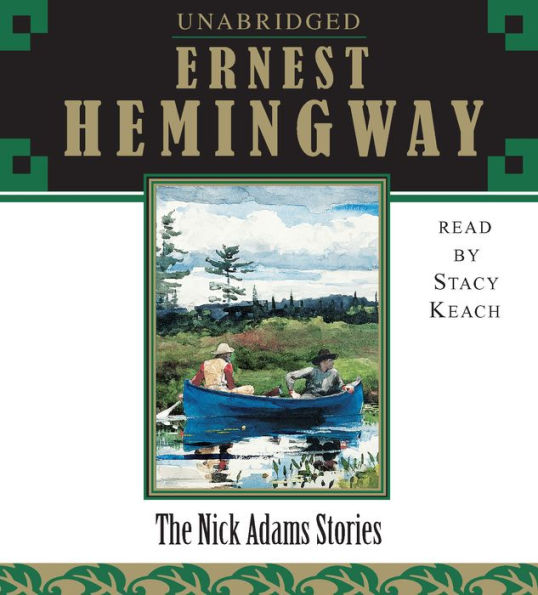Read an Excerpt
Nick Adams Stories
By Ernest Hemingway Scribner
Copyright © 1981 Ernest Hemingway
All right reserved. ISBN: 0684169401
Preface
"Of the place where he had been a boy he had written well enough. As well as he could then." So thought a dying writer in an early version of "The Snows of Kilimanjaro." The writer of course was Hemingway. The place was the Michigan of his boyhood summers, where he remembered himself as Nick Adams. As well as be could write then was very well indeed.
Until now, however, the stories involving Nick have always appeared so many to a book, in jumbled sequence. As a result the coherence of his adventures has been obscured, and their impact fragmented. In Men Without Women, Hemingway's second collection of stories, Nick appears first as a soldier in Italy, next as an adolescent in Summit, Illinois, then in turn as a younger boy in Michigan, a married man in Austria, and a soldier back in Italy. Or consider the trouble with "Big Two-Hearted River," one of the best-known Hemingway stories. Placed where it was -- at the end of In Our Time, the first collection -- it puzzled a good many readers. Put where it goes chronologically, following the stories of World War I, its submerged tensions -- the impression that Nick is exorcising some nameless anxiety -- become perfectly understandable. But "A Way You'll Never Be," which precedes "Big Two-Hearted River" in time and explains it, was published eight years and several books after it.
Arranged in chronological sequence, the events of Nick's life make up a meaningful narrative in which a memorable character grows from child to adolescent to soldier, veteran, writer, and parent -- a sequence closely paralleling the events of Hemingway's own life. In this arrangement Nick Adams, who for a long time was not widely recognized as a consistent character at all, emerges clearly as the first in a long line of Hemingway's fictional selves. Later versions, from Jake Barnes and Frederic Henry to Richard Cantwell and Thomas Hudson, were all to have behind them part of Nick's history and, correspondingly, part of Hemingway's.
As is true for many writers of fiction, the relationship between Hemingway's work and the events of his own life is an immediate and intricate one. In some stories he appears to report details of actual experience as faithfully as he might have entered them in a diary. In others the play of his imagination has transformed experience into a new and different reality. Exploring the connections between actuality and fiction in Hemingway can be an absorbing activity, and readers who wish to pursue it are referred to the biographical studies listed at the end of this preface. But Hemingway naturally intended his stories to be understood and enjoyed without regard for such considerations -- as they have been for a long time.
The first Nick Adams fiction appeared almost a half-century ago, the last in 1933, and over the years a great deal has been written about it. Among the unpublished manuscripts Hemingway left behind him, however, eight new contributions to the over-all narrative were discovered. Presented here for the first time, inserted in the places in time where the events fall, they are varied in length and apparent purpose. Three accounts -- of how the Indians left the country of Nick's boyhood, of his first sight of the Mississippi, and of what happened just before and after his wedding -- are quite brief. If the author had larger plans for any of them, such are unknown; they might be read simply as sketches in an artist's notebook. In two other cases his plans are self-evident, for here we have the beginnings of works that were never completed. Nick on board the Chicago, bound for France during World War I, was the start of a novel called Along with Youth that was abandoned long ago. Similarly, though much later, the plot of "The Last Good Country" was left in mid-air, and many pages would have been required to resolve it. Two other pieces are known to have originated in Nick stories already published. "Three Shots" tells how the young boy became frightened while on a camping trip. It once preceded the story called "Indian Camp." And Nick's "stream of consciousness" reflections on his writing career once (anachronistically) concluded "Big Two-Hearted River." Of these new works only "Summer People," very likely the first fiction Hemingway wrote about Nick Adams, can be regarded as a full-length, completed story.
To distinguish them from previously published works, all the new materials in this book have been printed in a special "oblique" type. If the decision to publish them at all is questioned, justification is available. For one thing, the plan for rearranging the Nick Adams stories coherently benefits from material that fills substantial gaps in the narrative. Further, all this new fiction relates in one way or another to events in the author's life, in which his readers continue to be interested. Last and most important is the fact that these pieces throw new light on the work and personality of one of our foremost writers and genuinely increase our understanding of him. The typography suggests an oblique introduction, but a warm reception is expected.
-- PHILIP YOUNG
Preface copyright © 1972 by Charles Scribner's Sons
Continues...
Excerpted from Nick Adams Stories by Ernest Hemingway Copyright © 1981 by Ernest Hemingway.
Excerpted by permission.
All rights reserved. No part of this excerpt may be reproduced or reprinted without permission in writing from the publisher.
Excerpts are provided by Dial-A-Book Inc. solely for the personal use of visitors to this web site.



